St. Louis Blues Players That Played In The Wrong Era

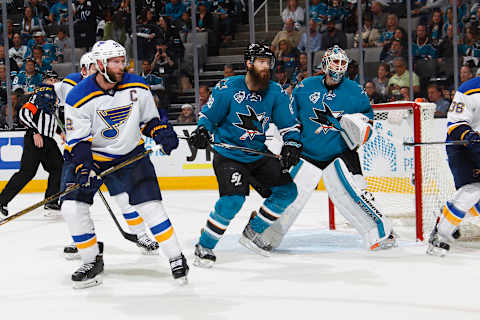
The St. Louis Blues have plenty of players that fit right into the years they played. However, some guys make you wonder if they were meant to have played in a different time.
The St. Louis Blues have had plenty of good players throughout their history. Some guys flourished because of the era they played in.
Still other guys did well but might have been even more successful if they had played in a different time. Those are the players we are going to look at here.
These are the players that had decent careers but could have done more in a different decade. Some of them might have been better suited physically.
Others might have tailored their game to the time they played, but their skills would have worked better now or in the past.
Some big guys had enough skill that they could have dominated when there were not as many skilled players, top to bottom, on a roster. Some small guys played during the clutch-and-grab eras and would have thrived in a more open game.
So, let’s look at some of the Blues that might have fit better in a time different than what they played.
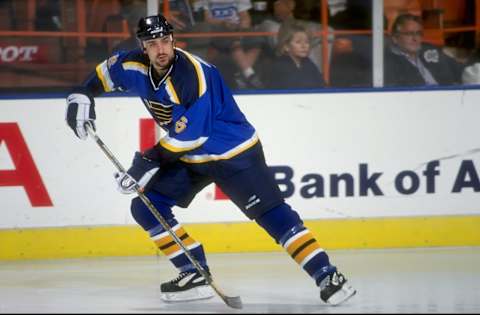
Jamie Rivers
Jamie Rivers was one of those players that you forget about because not much light was shown on him during his stay in St. Louis. That does not mean he was not a good player.
Like so many other former Blues, Rivers chose to make St. Louis his permanent home once he finally decided the playing days were over. That shows how much of an impact St. Louis can have on someone since he really only had two full seasons with The Note.
After playing with St. Louis, Rivers went on to have seasons with the New York Islanders, Ottawa Senators, Florida Panthers, Detroit Red Wings and Arizona Coyotes, as well as stints in Russia and Switzerland. The funny thing is he was actually quite talented for someone who jumped around so often and stayed in one place so little.
Rivers main problem was he did not quite fit with the era he came up in. While his career lasted through the time when the NHL was beginning to change, Rivers would have been better off playing in today’s NHL.
Rivers was a quick skater, even though he was not blessed with blazing speed. He also had good hands and was good at moving the puck.
Rivers showed his offensive side when he had more of an open opportunity in the AHL. Rivers scored as many as eight goals in one season and had a 52 point season with the Worchester IceCats.
He never really got the chance to shine in the NHL. He was often a third pairing defenseman with the Blues, and some of the other NHL teams.
Thus, he was asked to play a purely defensive role. Additionally, defensemen were not expected to jump into the play the way they are today.
Defenders would normally get their points on special teams or when the team had the play set up in the offensive zone. You put Rivers in today’s game and he likely could have thrived by joining in the rush with a team like St. Louis in 2019 where everyone went forward as a five-man unit.
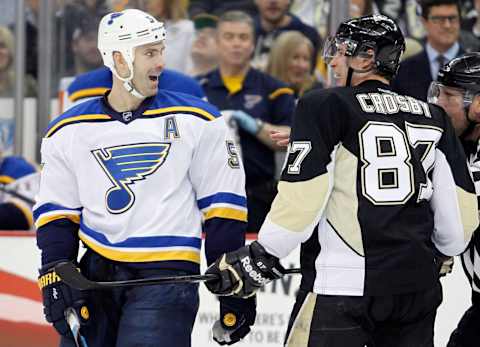
Barret Jackman
Barret Jackman is basically the total opposite of Rivers. Jackman would have been perfect playing in the 1990’s or even the 1980’s.
As his career went on, Blues fans forgot how good he could be. The narrative got spoiled because the game changed right when he came into the league.
Jackman was only in the league two seasons, one of which was shortened by injury, when the NHL lost a season to the lockout. That’s when the league changed their rules and players like Jackman were forced to adapt. To say he struggled a little might be understating it.
Jackman’s NHL was the clutch-and-grab style of the older days. He was still young enough to make the transition when it happened, but when you tailored your game a certain way for much of your younger career, and your physical attributes don’t match what the NHL was shifting toward, it makes it harder to switch.
Jackman’s footwork was not the best. He made up for it with grit and strength.
That was perfect for the league he came into. That’s exactly why he won the Calder Trophy for best rookie in the NHL.
That was proof that he was meant to be a pro player and was going to have a great career. He only ended up having a good career because things changed and he was slow to change with it.
Jackman started taking too many silly penalties after the lockout because he was still used to holding a guy back with his stick or grabbing their waist in the corner. Old habits die hard.
Sadly, one might make the case Jackman could have been an All-Star or even a Hall of Fame defender if the rules had stayed the same. Perhaps that’s a stretch, but his career would have been looked on with a lot more favor by Blues fans if he had played in the previous decade.
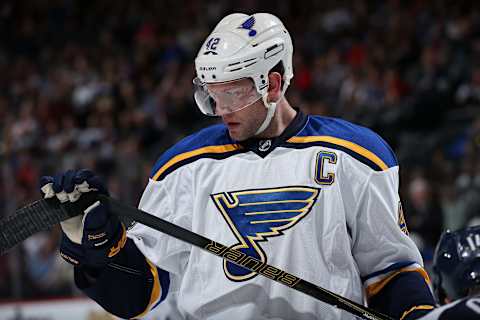
David Backes
Like Jackman, David Backes had a very solid career, especially with the St. Louis Blues. Like Jackman, he would have had a great career if he could have played in a previous decade.
Backes’ main style of game was to get to the front of the net and play with an edge in the corners. Like Jackman, playing in the era he did, Backes ended up taking some penalties that likely would not have been called had he played in a different time.
Put Backes in the early 1990’s and he would have been a beast. Someone with his size would have been almost unmovable in front of the net. He might have gotten chopped a little more by opposing goalies, but he might have scored more as well.
Conventional wisdom says he was fine in his era. Defenders were not able to move him out from the front of the crease like they could in the old days.
However, Backes’ style still fit a bygone era a little more. You might even place him back in the 1970’s.
Backes was not much of a fighter, but when you got his emotions going, he would battle with anyone.
During much of Backes’ career with the Blues, racking up 160-plus penalty minutes was not really seen as a good thing. If you’re sticking up for your teammate, so be it, but some of his penalties were stick infractions or holding because the footwork was not quite there.
Playing in a further back decade, he would have actually been one of the faster guys. Combine that with a bit of nastiness and he could dominate.
We might have seen him have more of his 30-goal seasons because he would have bulldozed opposing forwards. Only the defenders would have stood between him and the goal.
Just going to the 1990’s or early 2000’s would have fit Backes’ style a bit more. He might not have had the same overall talent, but he was very much in the mold of Keith Tkachuk who thrived during those times.
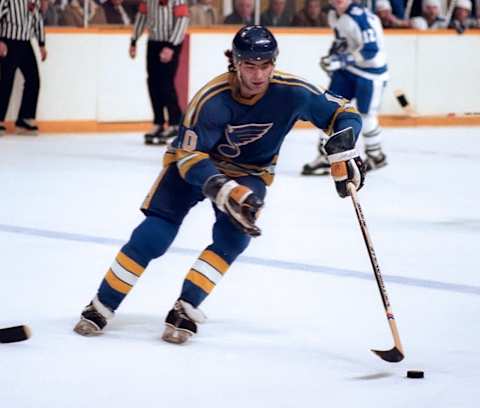
Wayne Babych
Switching back to the future, we look at the past. Wayne Babych was a player that would definitely have benefited from playing in today’s game.
If nothing else, he would have greatly benefited from modern medicine. That is not to say Babych played during the Stone Age.
His career was hampered by a shoulder injury. It was an injury that could have been prevented.
Babych scored 54 goals in just his third season in the NHL. Fun fact, he’s actually the first player to score 50 goals in one season with the Blues.
However, during a preseason game, Babych got into a fight. One of the officials tried to grab his arm during the scuffle, which caused a shoulder injury since Babych was still going for the punch and the official tried to stop it.
The injury didn’t truly cost him his career. He did go on to play six more seasons in the NHL.
However, he wore a shoulder sling after games the entire time. He also only scored 20 goals one more time in his career, when he was the beneficiary of playing RW alongside Mario Lemiuex. After that, he mostly scored goals in the mid-teens and points around the 40’s.
Put Babych in today’s game and he could either benefit from the slightly more open style, with less grabbing being allowed, or he would have benefited from modern technology possibly being able to heal his shoulder better. There’s no telling how good Babych could have been if he had a healthy shoulder.
Blues fans are now hoping Vladimir Tarasenko doesn’t suffer a similar fate. Tarasenko has yet to crack 50 goals, but you know the potential is there.
Babych knows from personal experience how difficult a shoulder injury is to come back from. Injuries happen no matter what era you play in, but it might have been more avoidable in today’s game.
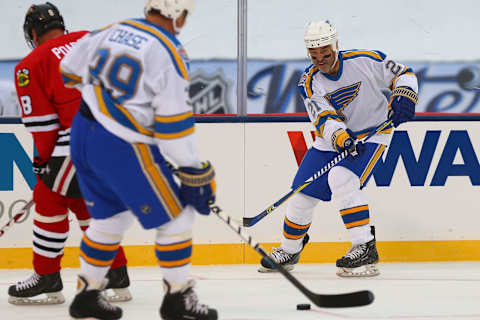
Jeff Brown
Like Bobby Orr, Jeff Brown was a player that achieved great things, but might have done even more if they played in a different era. That is not to say Brown was on Orr’s level, but merely to point out the style of play.
Even playing when he did, Brown achieved a lot as an offensive defenseman. He set career highs with the Blues when he scored 25 goals and 78 points.
For comparison, Al MacInnis‘ career bests were 28 goals and 103 points. So, Brown didn’t accrue as many assists, but he was almost as adept as a scorer.
Brown’s numbers went down when the NHL got into a dead area during the mid-1990’s. That’s when teams started emulating the New Jersey Devils with a more defense-oriented, trapping style of play.
It was not always fun to watch, but it was effective. Teams started asking Brown to focus more on the defensive end, which he did, but that took a lot away from his total game.
Imagine Brown playing in today’s game. Brown was a hard-nosed player, something he carried into being a junior coach, where he showed a lot of fire on the bench. You did not want to meet his icy stare if you made him mad.
However, he had an offensive game that did not match the era he played in. He scored a lot of goals, but was really the only defender venturing forward.
If he played in today’s game, where it is much more commonplace for defenders to join the rush and look to score, he could have easily been a 30-goal scorer. Even if the goals did not increase, the points likely would have.
Brown was not a selfish guy, but I feel like the assists would have increased with today’s style of play. Players specifically look to get deflections on defender’s shots now, where in the past those were a little more rare. Forwards did try, but it was not almost a set play like it is in today’s game.
Brown easily could have been a regular 70-80 point scorer in today’s game with his offensive skills. Throw in his tenacity, and you’ve got a well rounded player in today’s NHL, whereas he was thought of as almost too offensive minded during his day.
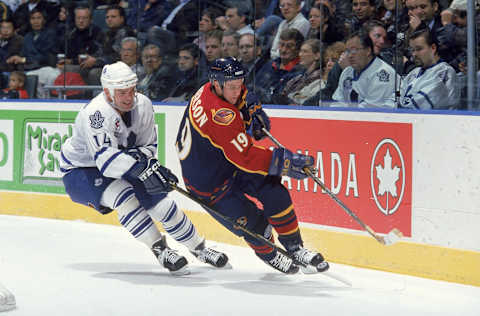
Nelson Emerson
Nelson Emerson was never hampered by his size. It was never like he was overly small, measuring in at 5’11 and 181 lbs.
However, he is another player that might have benefited from playing in today’s NHL. He still managed good stats in his day though.
Emerson’s career highs were 33 goals and 74 points. Of course, with St. Louis’ luck, those came the very season after the Blues traded him to the Winnipeg Jets.
Nevertheless, you wonder how he might have fared in today’s game as opposed to the early and mid-1990’s. He scored most of those points in a time when defenders could grab onto him to negate his speed or shiftiness.
Perhaps he gets up toward 40 goals or more playing in today’s game. Smaller players, with similar styles, like Alex Debrincat have eclipsed 40 goals.
Johnny Gaudreau is listed as 5’9 and has still managed to score 89 and 99 points in consecutive seasons, before having a down year in 2019-20.
Speed plays in the late 2010’s and early 2020’s. Like so many of the other forwards on here, Emerson got his points anyway. You just wonder how many more he would have gotten when defenders could not slow him down as much or bully him.
Next. One way or another, pandemic ruined Blues repeat chances. dark
The NHL will always be a physical game. It’s not as hard to get space now as it was during his day.
Maybe that’s only a handful of extra points during a season. Those all add up over the course of a career where Emerson already had 488 points.